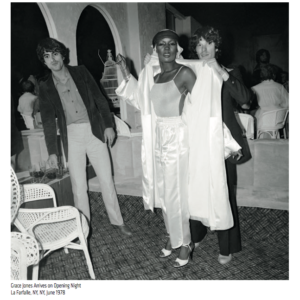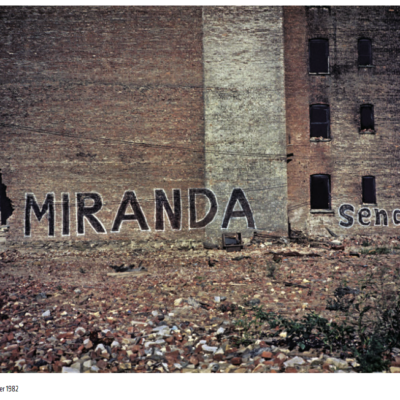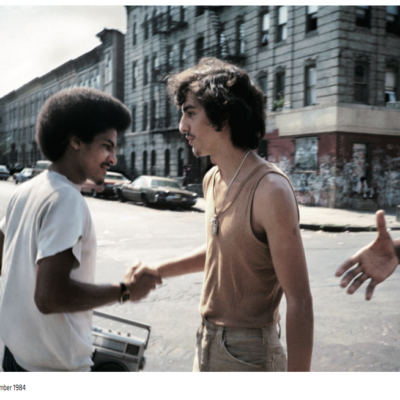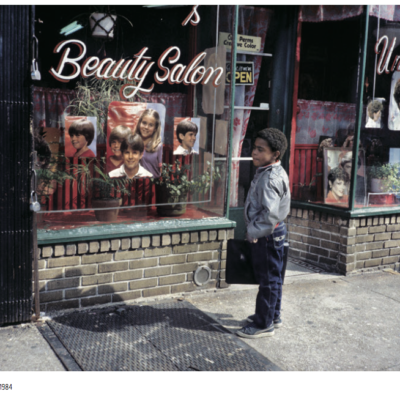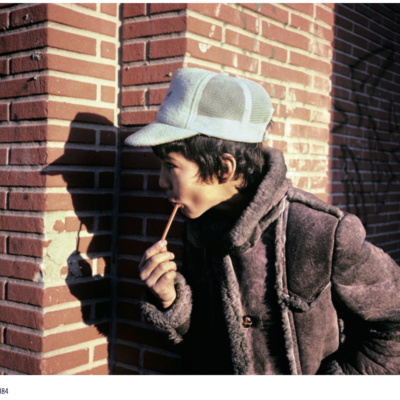I met Meryl Meisler in the late 90s. I was working for an education nonprofit and Meryl, a NYC teacher, was on their board. We hit it off immediately and have stayed in touch long after the nonprofit fell apart.
It’s been such a pleasure witnessing the well-deserved press Meryl’s documentary photography work has been getting over the last few years.
Meryl’s work does not focus on any of the four subjects featured in A Life’s Work. So why did I want to interview her? In addition to being a good friend, a wonderful person, and a fantastic artist, I am interested in anything or anyone with a very long view. And certainly Meryl fits in that category. As she says, “Making art is a process; it is my life’s work.”
When you were taking these photos, what were you intending to do with them?
These photographs were part of my Masters thesis exhibit at the University of Wisconsin at Madison. My exhibit consisted of drawings/illustrations and B&W photographic prints. They served their original purpose — to create a body of work and “defend” it in questioning with my thesis committee. The same photographs were used in a portfolio to be admitted to Lisette Model’s class at the New School when I moved to NYC in 1975. I kept pursuing the photographs of (predominantly Jewish) Long Island family and friends, and enrolled in a photography book course with Bob Adelman. He set me up with a writer to submit a proposal to a publishing company he was associated with, and the proposal was not accepted. I kept doing the series anyway, and in 1978, the work successfully helped me receive a C.E.T.A. project Artist position as a documentary photographer for the American Jewish Congress (AJC). I created a photographic archive of “Jewish New York” for AJC, which also included my personal project, interviewing and photographing extended family members to learn about my Eastern European Jewish roots and immigrating to the USA.
In the midst of all this, I was a young person coming of age in NYC in the 1970s and loving it. I carried my camera everywhere I went — clubs, discos, beach scenes, parties, on the streets day and night. My camera was my best friend and diary.
I was working as a freelance illustrator but photography was my passion. I set up a darkroom in the laundry room of my cousin’s building where I rented a room. Photography was and still is my passion and art. Several important people in the photography world, Cornell Capa and Lisette Model among them, were highly encouraging of my work — they saw something special in it. I thought I would be definitely famous by time I was 30. Alas, that did not happen. Perhaps that notion of fame might come by 75?
While working as a C.E.T.A. artist for AJC, we had to do community service. I chose to teach photography to homebound handicapped adults and to children. Even though my Bachelors degree was in art education, I was scared to teach. The community service work helped build up my confidence. When CETA ended in 1979, I was still doing freelance illustration work but the bills were coming in faster than the paychecks. I needed a steady job. The CETA teaching experience helped build my teaching confidence and portfolio. I became a NYC Public School Art Teacher, teaching photography four days a week “per diem” (no benefits) to elementary school students in the Learning to Read Through The Arts Program in September 1979. When a full time art teaching position with benefits opened up in Bushwick, December 1981, I started carrying a point and shoot camera to photograph going to and from school. When I began teaching, there was much less time for going out at night photographing or spending hours in the darkroom. I started working with color slide film and 35mm format because I needed to, wanted to photograph what I was witnessing and where I was going. I had a solo exhibit “School and Surroundings” in 1984 and it was prohibitively expensive for me to have archival Cibachrome color prints made on my teacher’s salary. I couldn’t afford to keep making the prints, but never stopped photographing. I started painting illustratively on some of the “bad” archival prints of Bushwick. The painted photographs of Bushwick was the body of work that was awarded a NYFA fellowship.
Throughout my 31 year career as a NYC public school art teacher I always worked on my own artwork — continuously exhibiting, applying for and sometimes receiving grants and commissions. I was always plugging away.
The Disco, Go-Go and other “decadent” nightlife photos were never exhibited. It would have put me at risk of losing my job and means of support. Upon retirement from the NYC public schools in 2010, I had more time to focus on getting my work “out there.”
What has it been like for you to go through so many photos that you took more than 30 years ago?
I’ve come to realize that for me, photography is a form of memoir. The photographs are like diary entries from 40 years ago. The moments and emotions are as fresh and still exciting. In the past, I’ve always had trouble editing my work. Time, distance, and the deadline for publishing a book help the decision process immensely. I’m actually impressed with how dynamic my photographs were right from the start and can say to my younger self- you have a good eye, mind, and heart.
Any thoughts or feelings about this work getting discovered instead of work that you’ve done in the last, say, five years?
David, I’ve always fretted that such and such series was too old or worried what will I work on next. For example when you and I met I was working on my NYC Immersions series. It was exhibited in Grand Central Terminal, in a poster throughout the transit system, in the Brooklyn Museum and thankfully a few pieces are permanently installed at the Columbia School of Social Work Library.
It was time to let that series go, “enough with the water,” but I didn’t know what to work on next and that was depressing. Then, a series of wonderful circumstances made me start digging through my Bushwick photographs from the 1980s and I realized how beautiful those images were. I became obsessed with them; I had no idea that they would be deemed historically important and the Bushwick art scene would become so phenomenal and welcoming.
Taking the time to dig through my archives makes me realize I’m always seeing, photographing, playing with brush and pigment. Looking at the past becomes the present. Good work stands the test of time, and ages well. With the gift of health and well being, I hope to continue digging through the archives and creating. Making art is a process; it is my life’s work.
What’s next?
I’m working on my next book, the third in the ‘70s trilogy. This one will make my first my first two books seem timid. I have to put the ‘70s in perspective to prepare for the subsequent chapters in this memoir continuously in the making.
Currently I’m documenting Resistance marches and rallies to show to the world we will not let the 45th administration destroy our country, heart and soul. In a new phase, hoping to get the urgent messages out to larger audience, I reported on the Women’s March on Washington for VICE and protests against Muslim Ban for Gothamist . Photographs from several marches will be hand painted and installed at a group exhibit “Fractured Union” at Brooklyn Fire Proof, 119 Ingraham St., Brooklyn. The exhibit opening reception is Friday May 12th 6 – 9PM and runs through June 2017.
I’ll be in a show of Brooklyn Photographers at BRIC house in September, and hopefully another solo show during Bushwick Open Studios in October. I’m working on a new series of self-portraits, returning to painting with photography. Then, I also want to continue finding, interviewing and photographing people who were in or knew the people and places in my Bushwick 1980s photos as a follow-up book to Disco Era Bushwick.
The most extensive body of my work that has yet to be seen is my 36 years from an insider’s point of view of NYC schools. I photographed throughout my career as a NYC teacher, and continued photographing 2011- 2015 as the NYU Art Education Field Supervisor, overseeing student teachers in both private and public schools.
With the gift of health and well-being, I hope to continue digging through the archives and creating new work for many years to come.
Thank you, Meryl.
==
Meryl Meisler is the author of the internationally acclaimed books A Tale of Two Cities Disco Era Bushwick, and Purgatory & Paradise SASSY ’70s Suburbia & The City.
You can read and see more of Meryl’s work in these publications.
The New Yorker – Andrea DenHoed – February 28, 2017
Backstage At The Ringling Brothers Circus, 1977
The New Yorker – Genevieve Fussell – June 3, 2015
Seventies Long Island: The Whole Mishpocha
The New Yorker – Genevieve Fussell – August 7, 2014
Meryl Meisler’s Disco Era
New York Times – Jonathan Mahler – June 13, 2014
Stayin’ Alive
Vice
A Tale of Two Cities: Disco Era Bushwick
Vice Video

